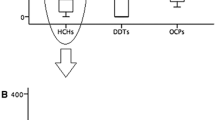Summary
Tetrachloroethene concentrations in blood and trichloroacetic acid concentrations in urine were determined — primarily over the course of a week — for 29 persons living in the vicinity of dry-cleaning shops. The mean levels of tetrachloroethene increased during the week. In some neighbours concentrations were exceeding the German biological threshold limit value for tetrachloroethene (1000 μg/l blood), persisting over the whole week in one case. The concentrations of tetrachloroethene in blood depended on the floor and the construction type of the building where these people were living, but not of the type of system used in the dry-cleaning shops. 5 of 12 drycleaners were found to have tetrachloroethene levels exceeding the German biological threshold limit value, some of them by a considerable amount.
Similar content being viewed by others
References
Bolt HM (1990) Tetrachlorethen. In: Henschler D, Lehnert G (eds): Deutsche Forschungsgemeinschaft. Biologische Arbeitsstoff-Toleranz-Werte (BAT-Werte) und Expositionsäquivalente für krebserzeugende Arbeitsstoffe (EKA). Arbeitsmedizinischtoxikologische Begründungen. Band 1. VCH, Weinheim
DFG (1991) Maximale Arbeitsplatzkonzentrationen und Biologische Arbeitsstofftoleranzwerte 1991. VCH, Weinheim
Gulyas H, Mirzaei F, Hemmerling L (1989) “Altlasten” durch einen ehemalige Münzreinigung. Forum Städte-Hygiene 40:314–316
Hajimiragha H, Ewers U, Jansen-Rosseck R, Brockhaus A (1986) Human exposure to volatile halogenated hydrocarbons from the general environment. Int Arch Occup Environ Health 58:141–150
Imbriani M, Ghittori S, Pezzagno G, Capodaglio E (1988) Urinary excretion of tetrachloroethylene (perchloroethylene) in experimental and occupational exposure. Arch Environ Health 43:292–298
Länderausschu\ für Immissionsschutz (1988) Perchlorethylen (PER). Beurteilung und Vorschläge zur Behebung von Problemen im Zusammenhang mit der Verwendung in Chemischreinigungen. Düsseldorf
Machata G, Angerer J (1988) Head-Space-Technik. Sammelmethode. In: Henschler D (ed) Deutsche Forschungsgemeinschaft. Analysen in biologischem Material. Analytische Methoden zur Prüfung gesundheitsschädlicher Arbeitsstoffe. Band 2. VCH, Weinheim
Ohde G, Bierod K (1989) Tetrachloräthylen-Belastung in der Nachbarschaft chemischer Reinigungen. Off Gesundh-Wes 51:626–628
Schaefer I, Hohmann H (1989) Tetrachlorethenbelastung bei Anwohnern von chemischen Reinigungen. Öff Gesundh-Wes 51:291–295
Wissenschaftlicher Beirat der Bundesärztekammer (1989) Belastung der Bevölkerung durch Perchlorethylen (PER, Tetrachlorethen). Dt Ärztebl 86:C2230–2241
Author information
Authors and Affiliations
Rights and permissions
About this article
Cite this article
Popp, W., Müller, G., Baltes-Schmitz, B. et al. Concentrations of tetrachloroethene in blood and trichloroacetic acid in urine in workers and neighbours of dry-cleaning shops. Int. Arch Occup Environ Heath 63, 393–395 (1992). https://doi.org/10.1007/BF00386934
Received:
Accepted:
Issue Date:
DOI: https://doi.org/10.1007/BF00386934




